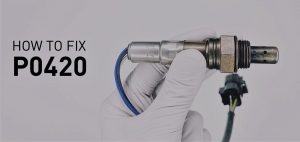Do you currently have the P0420 code displayed on your car’s dashboard as the check engine light comes on? Have you tried to wrap your head around why your car emits so much soot with the code still displaying? In the next few minutes, you’d learn what the code means, its causes, and practical steps on how to fix it.
Definition
The P0420 code detects your vehicle’s Catalyst System Efficiency Threshold (Bank one)
Meaning of P0420 Code
When you get the P0420 code on your vehicle’s computer screen, it means that the catalyst efficiency is below the threshold. The ECM makes this detection which is often caused by false alarms from the oxygen sensor or catalytic converter malfunction. The frequent air-fuel mixture could reduce the performance of the catalyst causing the P0420 code.
Your car’s Engine Control Module (ECM) works with two oxygen sensors. One of them is placed in front while the other seats behind the catalytic converter to help with the ECM readings. The P0420 gets triggered whenever the catalyst system efficiency falls below the average threshold. Most people get this error code as a result of a faulty catalytic converter.
P0420 Symptoms
To get ahead of the outcome of not attending to the P0420 error code, here are a few symptoms to work with.
- First, watch out for the check engine light on the vehicle’s dashboard
- In very few instances, you might notice increasing fuel consumption and misfires
- Be on the look for bad odor smell from the exhaust pipe
Causes of P0420
Knowing the causes of the error P0420 code would help you to avoid it in the future. Especially considering how costly and irresponsible the long-term effect would make you look. One of the following is the reason why your ECM detects the P0420 code;
- Driving with a fake catalytic converter
- Improper placement of the catalytic converter
- Faulty upstream front oxygen sensor or poor wiring
- Faulty downstream rear oxygen sensor or poor wiring
- Leakage in the exhaust
- Leakage in the intake section
- Oil burn from spillage causes damage to the catalytic converter
- Rich/lean mixture
- Misfires
- Bad Engine Control Unit (Highly rare)
Clearly, most of the causes of the P9420 error code revolve around the maintenance or performance of the catalytic converter. Some may also be associated with not getting the original or right OEM part as catalysts. Getting the most suitable catalyst from the manufacturer often does the trick when looking to get the ideal OEM part.
How Serious is the P0420 Code?
The error code doesn’t have as much impact on the overall performance of the vehicle’s engine as other vital ECM warnings. At worse, you could end up with a really damaged catalytic converter which would further reduce the car’s efficiency in the long run. When this happens, you might have a blocked exhaust flow which leaves the vehicle in a critical state.
In general, leaving the P0420 error code unattended would result in high HC and CO emissions from the exhaust. Aside from the fact that it makes you uncomfortable when driving, it’s mostly bad for the environment.
How to Fix the P0420 Code

- To begin, examine the condition of the catalytic converter before getting new parts
- If the catalytic converter is in great shape, clean thoroughly and take the vehicle for a test drive
- You might have to replace the catalytic converter after you notice any irregularity during the diagnostic test
- Try to invest in a genuine catalytic converter this time around
- Check before replacing the front oxygen sensor
- Check before replacing the rear oxygen sensor
- Inspect, repair, or change faulty wiring
- Fix oil burn
- Fix misfires
- Monitor and fix Rich/Lean fuel mixture
- Evaluate the data with your OBD2 Scanner
- Last resort: Change the Engine Control Unit
Common P0420 Diagnosis Mistakes
Most vehicle owners and engineers go straight to replacing the oxygen sensors without taking proper diagnoses. This common mistake often leads to spending unnecessarily or excess especially when the sensors are still functioning.
Often, the problem behind the error code can be traced to the working condition of the catalytic converter. With this truth, you should be able to predict the data with the results of the diagnosis except in cases when the problem spreads to cause misfires. Faulty oxygen sensors can also trigger the P0420 error but this only happens on extremely rare occasions.
Tools you Need
Even as basic as the error P0420 may sound, you need some tools to carry out the diagnosis and fix the problem. Here they are;
- Basic hand tools
- Laser Thermometer
- Diagnostic OBDII Scan Tool
- Multimeter
- Electrical contact cleaner
- Auto repair manual
How to Diagnose Code P0420
Again, before replacing any part, ensure you carry out the diagnostic tests the right way. Note that you could also clean the catalytic converter with additives in fuel tanks. Follow these steps to carry out a detailed diagnostic test on the P0420 error;
- Start by connecting the OBD2 Scanner to check for other trouble codes. Attend to all trouble codes related to the fuel or ignition system first
- Now check for live data to review the front and rear oxygen sensors. You should have your front sensor fluctuating between 0 and 1 volts while the rear sensor should maintain an average of 0.7 or 0.9 volt
- Next, let the engine run and check the temperature level at the front and rear sections of the catalytic converter. If there are no notable changes in temperature before and after the temperature check, then you have a bad catalytic converter
- Try removing the pipe from one end to properly inspect the catalytic converter for further damages
- Change to a genuine OEM catalytic converter if you notice any damage
Estimated Repair Cost
The cost may vary depending on your source for getting the parts and labor charges. Here’s a rough estimate of what you should expect to spend when fixing the P0420 error code. Note that this estimate does not cover the diagnostic test costs.
- Replacing the Catalytic Converter: $550 – $1550
- Replacing the Front Oxygen Sensor: $175 – $350
- Replacing the Rear Oxygen Sensor: $150 – $300



